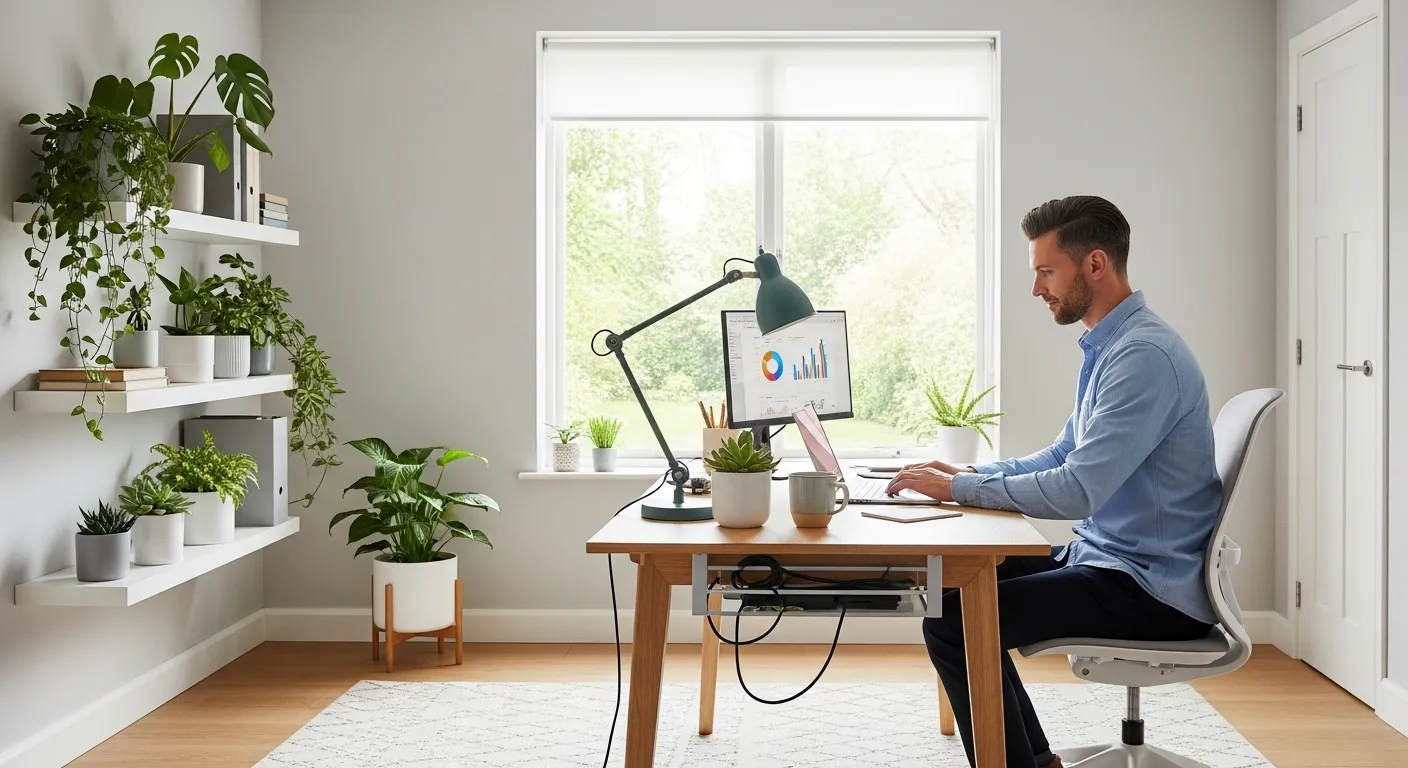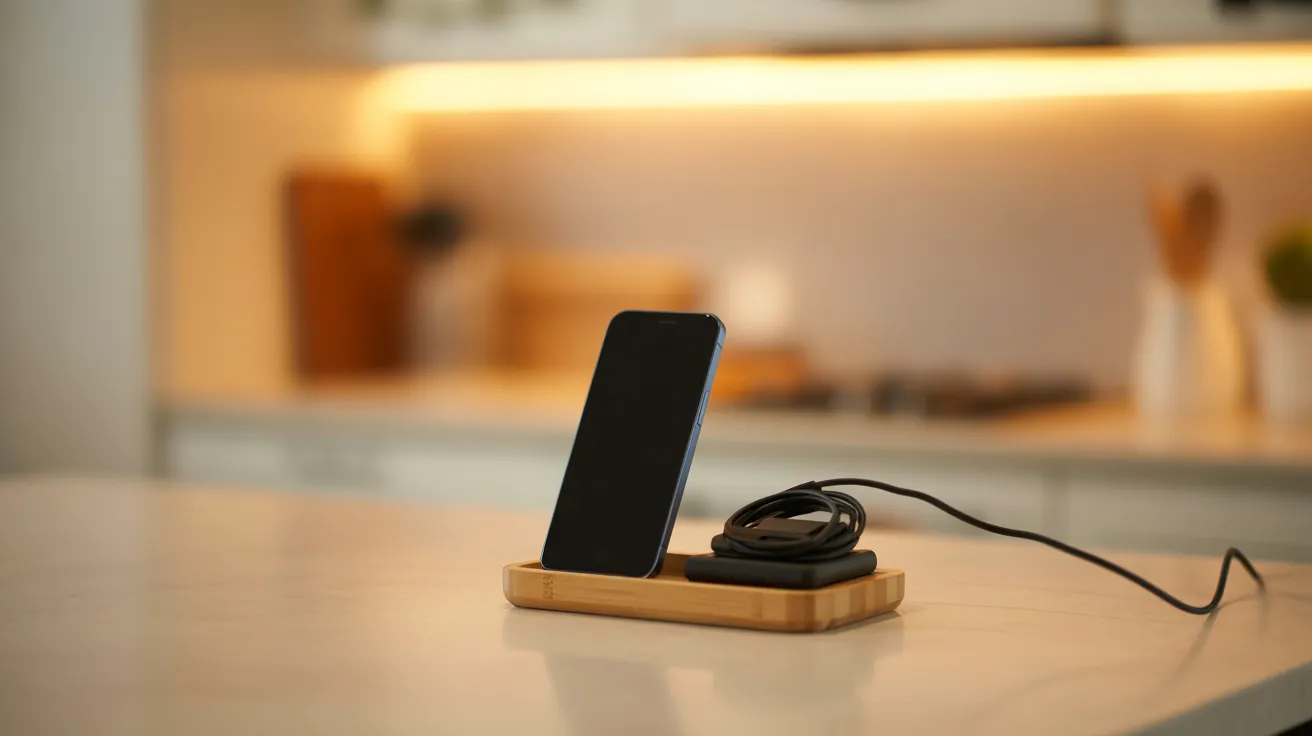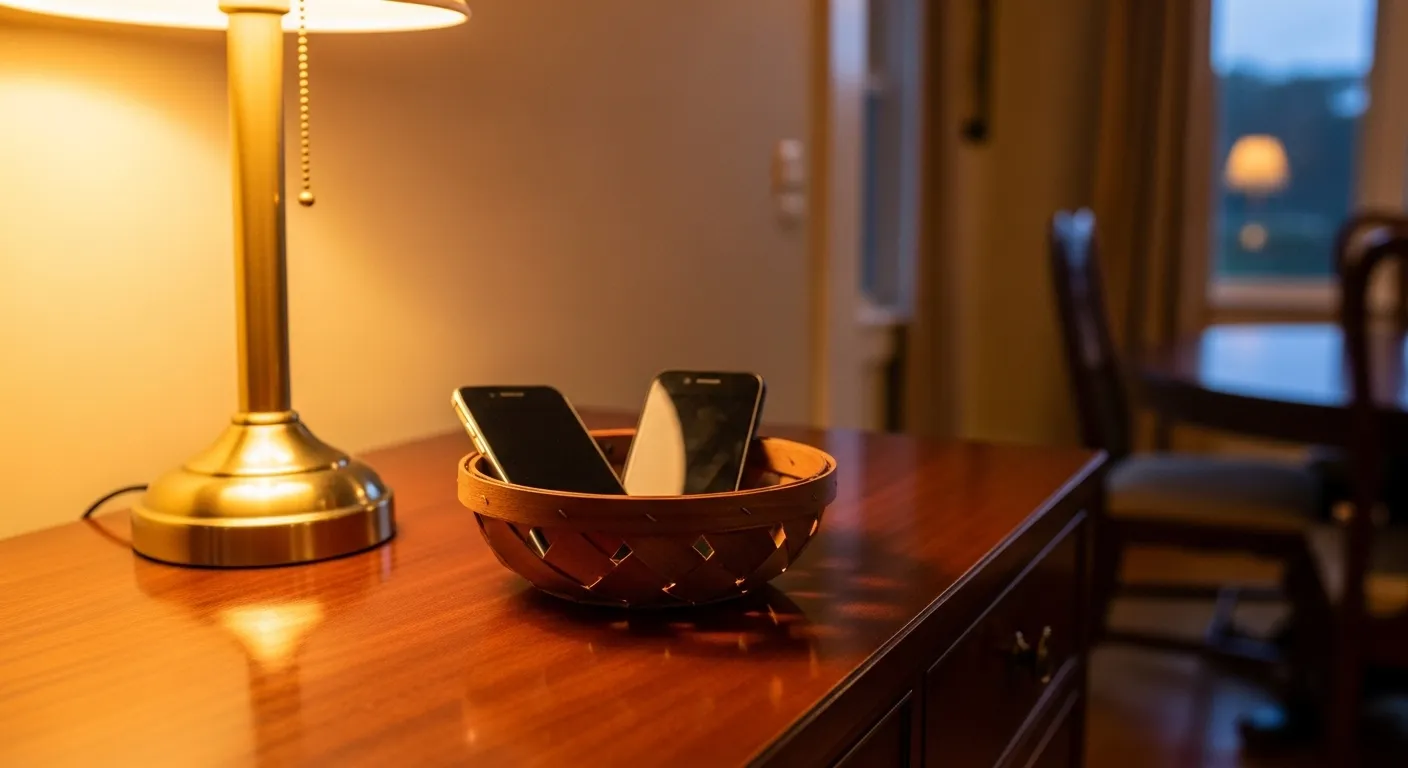
The glow is familiar. It’s the soft, rectangular light illuminating the face of a loved one across the dinner table. They’re physically present, but their attention is a million miles away, lost in a cascade of notifications, emails, and infinite scrolls. You might be doing the same, your fork in one hand and your digital world in the other. This scene has become the new normal for many of us, a quiet testament to how our devices have seamlessly woven themselves into the most intimate parts of our lives.
The cost of this constant connection is a subtle but significant disconnection—from our food, from our environment, and, most importantly, from each other. We eat without tasting, listen without hearing, and share space without truly sharing a moment. The meal, a timeless ritual of human connection and nourishment, is often reduced to a background activity, a necessary pit stop between digital engagements.
But what if there was a simple, powerful way to reclaim that time? What if you could build a small sanctuary of focus and presence in your day, without having to declare a full-blown war on technology? This isn’t about demonizing your smartphone or suggesting an unrealistic digital detox that leaves you feeling isolated. This is about being intentional. It’s about making a conscious choice to set a boundary for the sake of your well-being and your relationships.
The case for a “device-free” dinner is not a case against technology. It is a case for connection. It’s an invitation to rediscover the richness of a shared meal, the texture of a real conversation, and the simple peace of being fully present. Over the next few minutes, we’ll explore the subtle psychology that keeps us tethered to our screens and provide practical, balanced strategies to help you put your phone down, pick up your fork, and truly connect.
📚 Table of Contents
- Understanding the Tug-of-War for Your Attention
- Building Your Digital Guardrails: Proactive Routines
- Set Up a “Focus Mode” for Mealtimes
- Practice Notification Triage and Batching
- Curate a Minimalist Home Screen
- Use App Timers to Build Awareness
- Designing Your Environment for Focus and Calm
- The Power of Screen-Free Zones
- Protecting Your Sleep with a Tech-Free Evening
- Creating Cues for Disconnection
- Putting It Into Practice: Two Realistic Scenarios
- Navigating the Bumps in the Road
- Handling “Relapse” Moments
- Managing FOMO (Fear of Missing Out)
- Navigating Social Expectations
- Knowing When to Make Exceptions
- Frequently Asked Questions
- Q1: I’m concerned about my privacy with screen time and focus mode settings. How much data is being collected?
- Q2: I work a night shift, and my “dinner” is at 2 AM. How can I apply these principles when my schedule is so different?
- Q3: As a parent, I want to implement this for my kids, but they resist. What’s the best approach?
- Q4: My job requires me to be “on” and responsive, even in the evenings. How can I possibly have a device-free dinner?
- Your First Steps Toward a More Connected Meal
Understanding the Tug-of-War for Your Attention
To successfully create a tech-free home, or even just a tech-free mealtime, it helps to understand what you’re up against. It isn’t just a matter of willpower. Your devices and the apps on them are engineered by some of the brightest minds in the world with a singular goal: to capture and hold your attention for as long as possible. This isn’t a conspiracy; it’s just the business model of the attention economy.
At the core of this model is a powerful psychological principle. Many apps leverage a concept known as a dopamine loop. Dopamine is a neurotransmitter in your brain associated with pleasure and reward. When you do something enjoyable, like eating a delicious meal or receiving a compliment, your brain releases a small hit of dopamine, which makes you want to repeat the behavior. Digital platforms have perfected the art of triggering this system.
Think about the pull-to-refresh gesture on a social media feed. You pull down, wait a fraction of a second, and then… a reward. It might be a new photo from a friend, an interesting headline, or just a trivial update. The reward is unpredictable, a concept called “variable rewards.” This uncertainty is highly compelling. You never know if the next pull will deliver something amazing or nothing at all, so you keep pulling, just in case. It’s the same mechanism that makes slot machines in Las Vegas so addictive.
Notifications work in a similar way. The ping, buzz, or red bubble is a digital tap on the shoulder. It creates a sense of urgency and curiosity. Who liked my post? What’s in that email? Is this news important? Each notification is a small gamble, a promise of a potential social or informational reward. Responding to it completes the loop, giving you a tiny sense of accomplishment and a dopamine hit, which reinforces the habit of checking immediately.
This isn’t to say you are powerless. Understanding these mechanisms is the first step toward regaining control. It reframes the challenge from a personal failing (“I have no self-control”) to a strategic one (“How can I redesign my relationship with this powerful tool?”). The goal of a device-free dinner is to intentionally break that loop, even for just 30 minutes, and create space for other, more nourishing rewards—like genuine human interaction. As you begin to create these boundaries, you are not just fighting a habit; you are consciously stepping out of a system designed to keep you hooked. Research from institutions like the American Psychological Association continues to explore the complex effects of technology on human behavior, reinforcing the need for such mindful interventions.

Building Your Digital Guardrails: Proactive Routines
Reclaiming your dinner table requires more than just a good intention; it requires a plan. Instead of relying on sheer willpower in the moment, you can establish proactive routines and configure your devices to work for you, not against you. Think of these as digital guardrails that gently steer you toward your goal of a more present life.
Set Up a “Focus Mode” for Mealtimes
Modern smartphones, both Android and iOS, have powerful “Focus” or “Do Not Disturb” (DND) modes that are highly customizable. You can create a specific mode just for dinner. You might call it “Mealtime” or “Family Time.”
What is Do Not Disturb (DND)? It’s a setting that silences all incoming calls, texts, and notifications. A customizable Focus Mode is an evolution of this, allowing you to specify which apps and which people, if any, are allowed to break through the silence. For your “Mealtime” mode, you could block all notifications except for calls from a specific family member, like a parent or a child. You can even set it to activate automatically based on time (e.g., every day from 6:30 PM to 7:30 PM) or location (e.g., when you arrive home).
Practice Notification Triage and Batching
A constant stream of notifications fractures your attention. The solution is to move from a reactive to a proactive relationship with them. This is where notification batching comes in. It’s the practice of checking and responding to notifications in scheduled blocks, rather than as they arrive. Instead of letting every buzz pull you away, you decide when to engage.
Start by auditing your notifications. Go into your phone’s settings and turn off notifications for any app that isn’t truly time-sensitive. Do you really need a banner to tell you someone liked your photo or that a game has a special offer? Probably not. For the apps that remain, change as many as possible from instant alerts (banners and sounds) to silent delivery in the notification center. This way, they are waiting for you when you choose to look, not demanding your attention on their schedule.
Curate a Minimalist Home Screen
Your home screen is prime real estate. If it’s cluttered with distracting, brightly colored apps, it becomes a minefield of potential distractions every time you unlock your phone. A minimalist approach can dramatically reduce unintentional screen time.
Try removing all social media, news, and email apps from your home screen. Move them into a folder on the second or third page. This small amount of friction forces you to make a conscious choice to open them, rather than tapping on them out of habit. Your home screen can then be reserved for utility apps—maps, calendar, camera, notes. This transforms your phone from a temptation machine into a functional tool.
Use App Timers to Build Awareness
Most of us vastly underestimate how much time we spend on certain apps. App timers are a gentle, data-driven way to build awareness and enforce boundaries. In your phone’s digital wellness or screen time settings, you can set daily time limits for specific apps or categories of apps (e.g., 30 minutes for social media).
When you reach your limit, the phone will notify you. While you can often override it, the simple act of being reminded is a powerful nudge. It forces a moment of reflection: “Do I really want to keep scrolling, or could I be doing something else?” This isn’t about punishment; it’s about mindfulness. It helps you align your digital habits with your true intentions.

Designing Your Environment for Focus and Calm
Your physical environment sends powerful signals to your brain about how to behave. Just as you wouldn’t try to work in a chaotic, loud space, creating an environment conducive to connection is key to a successful device-free mealtime. By making small changes to your surroundings, you can make being present the path of least resistance.
The Power of Screen-Free Zones
A screen-free zone is a designated physical area where devices are simply not allowed. The dinner table is the perfect place to start, but the most effective zone for improving overall well-being is the bedroom.
Make the dining table a sacred space for food and conversation. The rule is simple: when you sit down to eat, phones do not come with you. Create a “landing strip” for devices elsewhere in your home—a small table in the hallway, a charging station in the kitchen, or a designated basket. When you walk in the door, your phone goes there. When it’s time for dinner, all household devices go there. This physical separation is far more effective than trying to resist the temptation of a phone sitting face down on the table.
Protecting Your Sleep with a Tech-Free Evening
The habit of a device-free dinner can naturally extend into a more sleep-friendly evening. The light from our screens can interfere with our natural sleep cycles. Specifically, the blue light emitted by phones, tablets, and computers can suppress the production of melatonin, the hormone that signals to your body that it’s time to sleep. According to experts at organizations like the Sleep Foundation, this can make it harder to fall asleep and can reduce the quality of the sleep you get.
Commit to making your bedroom a completely screen-free zone. This means no TV, no laptop, and especially no phone. Use a traditional alarm clock instead of your phone’s alarm. This removes the “I need it for my alarm” excuse that keeps the device by your bedside, tempting you with one last scroll. Establishing a 30-to-60-minute wind-down period before bed that is entirely screen-free allows your brain to shift gears, making the transition to sleep smoother and more natural.
Creating Cues for Disconnection
Just as a notification sound cues you to pick up your phone, you can create physical cues that signal it’s time to disconnect. These rituals help transition your brain from a state of high-alert, digital engagement to one of calm and presence.
Here are a few ideas you can use to signal the start of your device-free dinner:
– A clear space. Designate a specific spot, like a charging station in the kitchen or a basket by the door, where all devices “live” during dinner.
– A gentle sound. Use a simple chime or a specific song to signal the start of your device-free time.
– A verbal cue. A simple phrase like, “Okay, time to connect with each other,” can become a powerful part of the ritual.
These cues, when practiced consistently, build a new habit loop that replaces the old one of mindlessly bringing your phone to the table.

Putting It Into Practice: Two Realistic Scenarios
Theory is valuable, but practice is where change happens. Let’s walk through two concrete, achievable examples of how you can integrate these digital wellness principles into your life without feeling overwhelmed. These aren’t about perfection; they are about progress.
Example 1: A 10-Minute Evening Wind-Down Routine
The goal of this routine is to create a small, screen-free buffer between your busy day and your restful night. It’s short enough to be manageable even on the most hectic evenings.
Step 1 (Minute 0): The Tech Tuck-In. An hour before your intended bedtime, set an alarm on your phone labeled “Tech Tuck-In.” When it goes off, this is your cue. Plug your phone in to charge for the night—somewhere outside of your bedroom. The kitchen counter or a desk in another room is perfect. Say goodnight to your digital world.
Step 2 (Minutes 1-5): Prepare for Tomorrow. With your phone out of reach, use the next five minutes to do something simple to ease tomorrow’s morning rush. Maybe you lay out your clothes, pack your gym bag, or tidy one small area of your living space. This act of physical organization has a calming effect on the mind.
Step 3 (Minutes 6-10): Analog Relaxation. For the final five minutes, engage in a non-digital activity. This could be light stretching, reading a few pages of a physical book or e-reader (one without browser access), journaling about your day, or simply sitting quietly and focusing on your breath. This small moment of peace helps your brain decelerate, preparing you for better sleep, a cornerstone of health highlighted by research from the National Institutes of Health.
Example 2: A Realistic Weekend Digital Detox
The idea of a full “digital detox” can be daunting, especially if your social life and logistics rely on your phone. This version is more of a “digital de-emphasis,” focusing on intentionality rather than complete disconnection.
Friday Evening: Set the Stage. Before your weekend begins, decide on one or two “analog” activities you want to do. This could be a hike, visiting a museum, trying a new recipe, or playing a board game. Having a plan gives you a positive alternative to mindless scrolling. Tidy up your phone’s home screen and set app timers for the weekend.
Saturday: The “No-Phone” Morning. For the first two or three hours of your Saturday, leave your phone in another room. Wake up, make breakfast, read the paper, talk to your family, or go for a walk without it. You’ll be amazed at how different the morning feels. For the rest of the day, use your phone as a tool, not a companion. Use it for logistics—maps, calling a friend to meet up—but then put it away. Avoid aimless browsing.
Sunday: A Social Media Sabbath. Designate Sunday as a day off from social media. You don’t have to delete the apps; just don’t open them. This isn’t about ignoring your friends; it’s about giving your brain a rest from the comparison and performance culture that can often accompany these platforms. Instead, call or text a friend to connect directly. Use the time you would have spent scrolling to engage in one of the analog activities you planned. By Sunday evening, you’ll feel more rested and mentally prepared for the week ahead.

Navigating the Bumps in the Road
Embarking on a journey toward healthier tech habits is not a linear path. There will be moments of relapse, feelings of anxiety, and social hurdles to overcome. Anticipating these challenges and having a strategy to deal with them is crucial for long-term success. Remember, the goal is balance, not flawless perfection.
Handling “Relapse” Moments
You will have dinners where, out of habit, you pull out your phone. It’s inevitable. The key is how you respond. Don’t fall into a cycle of guilt or shame. That’s counterproductive. Instead, simply notice it without judgment. Acknowledge the impulse, gently put the phone back in its designated spot, and return your attention to your meal and the people you’re with. Every time you do this, you are strengthening the “presence” muscle. Each meal is a new opportunity to practice.
Managing FOMO (Fear of Missing Out)
When you first put your phone away, you might feel a pang of anxiety. What if I’m missing an important email? What if something major is happening on social media? This is FOMO, and it’s a powerful feeling fueled by the constant-update culture of our digital world. The best way to combat it is with data and experience. After a few device-free dinners, you’ll start to realize that very little happens in that 30-minute window that truly requires your immediate attention. The world will still be there when you’re done. You are not missing out; you are opting in to the life right in front of you.
Navigating Social Expectations
What if you’re out to dinner with friends or family who are all on their phones? This can be tricky. You can’t impose your rules on others, but you can lead by example. Keep your own phone put away. Engage the people around you in conversation. Often, one person modeling this behavior is enough to get others to look up from their screens.
If you feel comfortable, you can even make it a lighthearted suggestion. Something like, “Hey, how about we try a ‘phone stack’? Everyone puts their phone in the middle of the table, and the first person to grab theirs has to pick up the bill.” It can turn the idea into a fun game rather than a preachy rule. The most important thing is to manage your own habits first.
Knowing When to Make Exceptions
A device-free dinner is a guideline, not an unbreakable law. Life is complicated, and there will be times when an exception is necessary. Perhaps you’re a doctor on call, waiting for an urgent page. Maybe you’re expecting an important call about a family matter. Or perhaps you want to use your phone together to look up a fun fact that came up in conversation or to play a song everyone enjoys.
The key is intentionality. The difference is between mindlessly scrolling through a feed and consciously using the device for a specific, shared purpose. If you need to have your phone available for a legitimate reason, communicate that to your dining companions. This preserves the spirit of the rule, which is to prioritize presence and connection.

Frequently Asked Questions
Q1: I’m concerned about my privacy with screen time and focus mode settings. How much data is being collected?
A: This is a valid concern. The good news is that built-in digital wellness tools from major operating system providers like Apple (Screen Time) and Google (Digital Wellbeing) are designed to process this data on your device itself. This means that your specific app usage data, notification counts, and pickup habits are generally not sent to their servers or shared with third parties. They are used locally to provide you with your personal reports and to enable the features like app timers and focus modes. However, it’s always wise to review the specific privacy policy for your device to be fully informed.
Q2: I work a night shift, and my “dinner” is at 2 AM. How can I apply these principles when my schedule is so different?
A: The principles of a device-free meal are universal and not tied to a specific time of day. The goal is to carve out a moment of mindful eating and disconnection, whenever that may be for you. If your main meal is in the middle of the night, that is your time to disconnect. The same rules apply: put your phone away, eat without digital distractions, and focus on your food and your own thoughts. If you eat with colleagues on a similar schedule, you can even encourage a group commitment to a device-free break, which can build camaraderie and provide a much-needed mental reset during a demanding shift.
Q3: As a parent, I want to implement this for my kids, but they resist. What’s the best approach?
A: The most effective strategy is to lead by example and make it a family-wide agreement, not a top-down rule just for children. Frame it as something positive the family is doing together to spend more quality time. Use a central charging basket where everyone, parents included, deposits their devices before dinner. This demonstrates that the rule is fair and that you’re not asking them to do something you’re unwilling to do yourself. You can also explore parental control settings on their devices to automatically limit app access during dinnertime, which can help automate the process and reduce daily negotiations.
Q4: My job requires me to be “on” and responsive, even in the evenings. How can I possibly have a device-free dinner?
A: This is a common challenge in our always-on work culture. The key is to create nuanced boundaries. Use the “Focus Mode” feature to allow calls or messages only from your boss or a specific work-related number while blocking everything else. Communicate your boundaries to your team: “I am offline for dinner from 7:00 to 7:45 PM but will be available afterward. If there is a true emergency, please call me.” Most work issues are not true emergencies that can’t wait 45 minutes. Establishing this small window of unavailability not only benefits you but also helps set a healthier precedent within your workplace culture.

Your First Steps Toward a More Connected Meal
Reclaiming your attention and fostering deeper connections doesn’t require a radical overhaul of your life. It begins with small, consistent, and intentional choices. The device-free dinner is more than just a rule; it’s a practice in mindfulness, a commitment to presence, and a powerful symbol of what you value most. It’s a declaration that for this small part of the day, your focus belongs to the people and the nourishment right in front of you.
You don’t need to implement every strategy we’ve discussed at once. The path to healthier digital habits is a marathon, not a sprint. The goal is to find what works for you, your family, and your lifestyle. Be patient with yourself, celebrate the small victories, and remember that every moment of reclaimed presence is a win.
To get started, choose just one or two of these simple actions to try this week:
1. Designate a “Phone Home.” Find a spot outside of your dining area—a basket, a shelf, a charging station—and make it the official home for all devices during your meal.
2. Set Up a Simple Focus Mode. Take five minutes to create a “Mealtime” focus mode on your phone that blocks all notifications. Set it to turn on automatically every evening.
3. Start with One Meal. Don’t try to go device-free for every meal right away. Commit to just one meal a day—or even just a few dinners a week—to start building the habit.
4. Talk About It. Share this idea with your family or partner. Explain why it’s important to you. Creating a shared goal makes it easier and more meaningful to stick with.
By taking these small steps, you can begin to shift the balance back in your favor, transforming mealtime from a moment of distraction into an opportunity for genuine connection. You have the power to decide where your attention goes. Choose to give it to what, and who, truly matters.
Disclaimer: The information provided in this article is for educational and informational purposes only and is not intended as a substitute for professional medical or psychological advice. Always seek the advice of your physician or other qualified health provider with any questions you may have regarding a medical condition or mental health.






